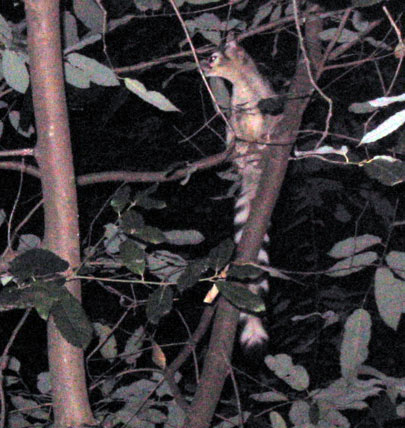 |
|
||||||||||||||||||
 Ring Tailed cats are rarely seen in Big Sur and although called "cats" they are related to racoons. They exist in the lower altitudes from sea level up the steep canyons. Ring Tailed cats are rarely seen in Big Sur and although called "cats" they are related to racoons. They exist in the lower altitudes from sea level up the steep canyons.Ringtails enjoy habitat with rocky outcroppings, talus slopes, and canyons and can be found in semi-arid country, deserts, chaparral, oak woodlands, all of which are part of the diverse eco-system of Big Sur. They are also known to enjoy riparian ecosystems which stripe the coastal canyons below the chaparral ridgelines. Ringtails are nocturnal animals and spend most of their time foraging for food. After feeding, a ringtail grooms itself while sitting on its hindquarters, much like a cat. Then it licks its fur and paws, wiping its cheeks, mouth, and ears. Ringtails are great climbers, moving quickly among cliffs, richocheting from wall to wall. They also shimmy up small crevices and can be found in trees. Ringtails live solitary lives except during the mating season. They are known to have a variety of vocalizations. Adults emit an explosive bark, a pierceing scream, and a long, high-pitched call. Infants vocalize with metallic chirps, squeaks, and wimpers. Scent appears to be as important as vocalizations for communication with the species. Ringtails mark their territory by rubbing urine on the ground and on raised objects. During maiting season, ringtails increase their marking  activity to aattract a mate and to deter competitors of the same sex. activity to aattract a mate and to deter competitors of the same sex.Ringtails are omnivorous but prefer eating animals depending on seasonal abundance. They like eating rodents, rabbits, squirrels and insects. They are also known to eat birds, lizards, snakes, frogs and carrion. They've also been recorded eating acorns, mistletoe, juniper berries, persimmons, wild figs and other fruits. When threatened Ringtails will bristle the hair on its tail, arching the tail over its back towards its head, making itself look larger. Known predators are Great horned owls, Coyote, and Bobcats. Ringtails life spans are 7 years in the wild and 14 years in captivity. Information gathered from the University of Michigan animal diversity website. Photographs by Kayl Seymour Download our local Big Sur Visitors Guide in Adobe PDF. |
|
|
Big Sur Chamber of Commerce - http://www.bigsurcalifornia.org (831) 667-2100